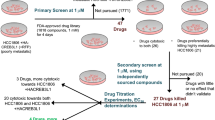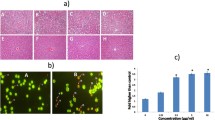Abstract
Multidrug resistance is the major obstacle for successful treatment of breast cancer, prompting the investigation of novel anticancer compounds.
Purpose
In this study, we tested whether LQB-223, an 11a-N-Tosyl-5-deoxi-pterocarpan newly synthesized compound, could be effective toward breast cancer cells.
Methods
Human breast cell lines MCF-7, MDA-MB-231, HB4a and MCF-7 DoxR were used as models for this study. Cell culture, MTT and clonogenic assay, flow cytometry and Western blotting were performed.
Results
The LQB-223 decreased cell viability, inhibited colony formation and induced an expressive G2/M arrest in breast cancer cells. There was an induction in p53 and p21Cip1 protein levels following treatment of wild-type p53 MCF-7 cells, which was not observed in the mutant p53 MDA-MB-231 cell line, providing evidence that the compound might act to modulate the cell cycle regardless of p53 status. In addition, LQB-223 resulted in decreased procaspase levels and increased annexin V staining, suggesting that the apoptotic cascade is also triggered. Importantly, LQB-223 treatment was shown to be less cytotoxic to non-neoplastic breast cells than docetaxel and doxorubicin. Strikingly, exposure of doxorubicin-resistant MCF-7-DoxR cells to LQB-223 resulted in suppression of cell viability and proliferation in levels comparable to MCF-7. Of note, MCF-7-DoxR cells have an elevated expression of the P-glycoprotein efflux pump when compared to MCF-7.
Conclusion
Together, these results show that LQB-223 mediates cytotoxic effects in sensitive and resistant breast cancer cells, while presenting low toxicity to non-neoplastic cells. The new compound might represent a potential strategy to induce toxicity in breast cancer cells, especially chemoresistant cells.






Similar content being viewed by others
References
Azim HA Jr, de Azambuja E, Colozza M, Bines J, Piccart MJ (2011) Long-term toxic effects of adjuvant chemotherapy in breast cancer. Ann Oncol 22:1939–1947. doi:10.1093/annonc/mdq683
Bird BR, Swain SM (2008) Cardiac toxicity in breast cancer survivors: review of potential cardiac problems. Clin Cancer Res 14:14–24. doi:10.1158/1078-0432.CCR-07-1033
Borresen-Dale AL (2003) TP53 and breast cancer. Hum Mutat 21:292–300. doi:10.1002/humu.10174
Buarque CD et al (2011) Pterocarpanquinones, aza-pterocarpanquinone and derivatives: synthesis, antineoplasic activity on human malignant cell lines and antileishmanial activity on Leishmania amazonensis. Bioorganic Med Chem 19:6885–6891. doi:10.1016/j.bmc.2011.09.025
Buarque DS et al (2013) Differential expression profiles in the midgut of Triatoma infestans infected with Trypanosoma cruzi. PLoS ONE 8:e61203. doi:10.1371/journal.pone.0061203
Buarque CD, Salustiano EJ, Fraga KC, Alves BR, Costa PR (2014) 11a-N-Tosyl-5-deoxi-pterocarpan (LQB-223), a promising prototype for targeting MDR leukemia cell lines. Eur J Med Chem 78:190–197. doi:10.1016/j.ejmech.2014.03.039
Burnell M et al (2010) Cyclophosphamide, epirubicin, and Fluorouracil versus dose-dense epirubicin and cyclophosphamide followed by Paclitaxel versus Doxorubicin and cyclophosphamide followed by Paclitaxel in node-positive or high-risk node-negative breast cancer. J Clin Oncol 28:77–82. doi:10.1200/JCO.2009.22.1077
Chargari C, Toillon RA, Macdermed D, Castadot P, Magne N (2009) Concurrent hormone and radiation therapy in patients with breast cancer: what is the rationale? Lancet Oncol 10:53–60. doi:10.1016/S1470-2045(08)70333-4
Chen YN, Mickley LA, Schwartz AM, Acton EM, Hwang JL, Fojo AT (1990) Characterization of adriamycin-resistant human breast cancer cells which display overexpression of a novel resistance-related membrane protein. J Biol Chem 265:10073–10080
Chernov MV, Stark GR (1997) The p53 activation and apoptosis induced by DNA damage are reversibly inhibited by salicylate. Oncogene 14:2503–2510. doi:10.1038/sj.onc.1201104
Chintamani, Singh JP, Mittal MK, Saxena S, Bansal A, Bhatia A, Kulshreshtha P (2005) Role of p-glycoprotein expression in predicting response to neoadjuvant chemotherapy in breast cancer–a prospective clinical study. World J Surg Oncol 3:61 doi:10.1186/1477-7819-3-61
Curtis C et al (2012) The genomic and transcriptomic architecture of 2,000 breast tumours reveals novel subgroups. Nature 486:346–352. doi:10.1038/nature10983
de Faria FC, Leal ME, Bernardo PS, Costa PR, Maia RC (2015) NFkappaB pathway and microRNA-9 and -21 are involved in sensitivity to the pterocarpanquinone LQB-118 in different CML cell lines. Anticancer Agents Med Chem 15:345–352
de Souza Reis FR et al (2013) The therapeutical potential of a novel pterocarpanquinone LQB-118 to target inhibitor of apoptosis proteins in acute myeloid leukemia cells. Anticancer Agents Med Chem 13:341–351
el-Deiry WS et al (1993) WAF1, a potential mediator of p53 tumor suppression. Cell 75:817–825
Gewirtz DA (1999) A critical evaluation of the mechanisms of action proposed for the antitumor effects of the anthracycline antibiotics adriamycin and daunorubicin. Biochem Pharmacol 57:727–741
Gottesman MM, Fojo T, Bates SE (2002) Multidrug resistance in cancer: role of ATP-dependent transporters. Nat Rev Cancer 2:48–58. doi:10.1038/nrc706
Greenberger LM, Williams SS, Horwitz SB (1987) Biosynthesis of heterogeneous forms of multidrug resistance-associated glycoproteins. J Biol Chem 262:13685–13689
Hernandez-Vargas H, Palacios J, Moreno-Bueno G (2007) Molecular profiling of docetaxel cytotoxicity in breast cancer cells: uncoupling of aberrant mitosis and apoptosis. Oncogene 26:2902–2913. doi:10.1038/sj.onc.1210102
Ho DH et al (2015) Leucine-Rich Repeat Kinase 2 (LRRK2) phosphorylates p53 and induces p21(WAF1/CIP1) expression Mol. Brain 8:54. doi:10.1186/s13041-015-0145-7
Holohan C, Van Schaeybroeck S, Longley DB, Johnston PG (2013) Cancer drug resistance: an evolving paradigm. Nat Rev Cancer 13:714–726. doi:10.1038/nrc3599
Kim CW, Asai D, Kang JH, Kishimura A, Mori T, Katayama Y (2015) Reversal of efflux of an anticancer drug in human drug-resistant breast cancer cells by inhibition of protein kinase Calpha (PKCalpha) activity Tumour Biol doi:10.1007/s13277-015-3963-4
Knappskog S et al (2015) Concomitant inactivation of the p53- and pRB- functional pathways predicts resistance to DNA damaging drugs in breast cancer in vivo. Mol Oncol 9:1553–1564. doi:10.1016/j.molonc.2015.04.008
Kumler I, Stenvang J, Moreira J, Brunner N, Nielsen DL (2015) Drug transporters in breast cancer: response to anthracyclines and taxanes. Expert Rev Anticancer Ther 15:1075–1092. doi:10.1586/14737140.2015.1067610
Larsen AK, Skladanowski A (1998) Cellular resistance to topoisomerase-targeted drugs: from drug uptake to cell death. Biochim Biophys Acta 1400:257–274
Ling YH, Priebe W, Perez-Soler R (1993) Apoptosis induced by anthracycline antibiotics in P388 parent and multidrug-resistant cells. Cancer Res 53:1845–1852
Linn SC et al (1997) Expression of drug resistance proteins in breast cancer, in relation to chemotherapy. Int J Cancer 71:787–795
Liu D et al (2015) Infection by Cx43 adenovirus increased chemotherapy sensitivity in human gastric cancer BGC-823 cells: not involving in induction of cell apoptosis. Gene 574:217–224. doi:10.1016/j.gene.2015.08.052
Lyu YL, Lin CP, Azarova AM, Cai L, Wang JC, Liu LF (2006) Role of topoisomerase IIbeta in the expression of developmentally regulated genes. Mol Cell Biol 26:7929–7941. doi:10.1128/MCB.00617-06
Maia RC et al (2011) LQB-118, a pterocarpanquinone structurally related to lapachol [2-hydroxy-3-(3-methyl-2-butenyl)-1,4-naphthoquinone]: a novel class of agent with high apoptotic effect in chronic myeloid leukemia cells. Invest New Drugs 29:1143–1155. doi:10.1007/s10637-010-9453-z
Martino T, Magalhaes FC, Justo GA, Coelho MG, Netto CD, Costa PR, Sabino KC (2014) The pterocarpanquinone LQB-118 inhibits tumor cell proliferation by downregulation of c-Myc and cyclins D1 and B1 mRNA and upregulation of p21 cell cycle inhibitor expression. Bioorganic Med Chem 22:3115–3122. doi:10.1016/j.bmc.2014.04.025
Millour J et al (2011) ATM and p53 regulate FOXM1 expression via E2F in breast cancer epirubicin treatment and resistance. Mol Cancer Ther 10:1046–1058. doi:10.1158/1535-7163.MCT-11-0024
Mosmann T (1983) Rapid colorimetric assay for cellular growth and survival: application to proliferation and cytotoxicity assays. J Immunol Methods 65:55–63
Murray S, Briasoulis E, Linardou H, Bafaloukos D, Papadimitriou C (2012) Taxane resistance in breast cancer: mechanisms, predictive biomarkers and circumvention strategies. Cancer Treat Rev 38:890–903. doi:10.1016/j.ctrv.2012.02.011
Nestal de Moraes G et al (2014) The pterocarpanquinone LQB-118 induces apoptosis in acute myeloid leukemia cells of distinct molecular subtypes and targets FoxO3a and FoxM1 transcription factors. Int J Oncol 45:1949–1958. doi:10.3892/ijo.2014.2615
Netto CD et al (2010) New pterocarpanquinones: synthesis, antineoplasic activity on cultured human malignant cell lines and TNF-alpha modulation in human PBMC cells. Bioorganic Med Chem 18:1610–1616. doi:10.1016/j.bmc.2009.12.073
Panis C et al (2012) Immunological effects of taxol and adryamicin in breast cancer patients. Cancer Immunol Immunother 61:481–488. doi:10.1007/s00262-011-1117-0
Perou CM et al (2000) Molecular portraits of human breast tumours. Nature 406:747–752. doi:10.1038/35021093
Prives C (1993) Doing the right thing: feedback control and p53. Curr Opin Cell Biol 5:214–218
Riordan JR, Ling V (1985) Genetic and biochemical characterization of multidrug resistance. Pharmacol Ther 28:51–75
Shalli K, Brown I, Heys SD, Schofield AC (2005) Alterations of beta-tubulin isotypes in breast cancer cells resistant to docetaxel. FASEB J 19:1299–1301. doi:10.1096/fj.04-3178fje
Sherr CJ (1993) Mammalian G1 cyclins. Cell 73:1059–1065
Smith LA, Cornelius VR, Plummer CJ, Levitt G, Verrill M, Canney P, Jones A (2010) Cardiotoxicity of anthracycline agents for the treatment of cancer: systematic review and meta-analysis of randomised controlled trials. BMC Cancer 10:337. doi:10.1186/1471-2407-10-337
Stamps AC, Davies SC, Burman J, O’Hare MJ (1994) Analysis of proviral integration in human mammary epithelial cell lines immortalized by retroviral infection with a temperature-sensitive SV40 T-antigen construct. Int J Cancer 57:865–874
Swain SM, Whaley FS, Ewer MS (2003) Congestive heart failure in patients treated with doxorubicin: a retrospective analysis of three trials. Cancer 97:2869–2879. doi:10.1002/cncr.11407
Szakacs G et al (2014) Targeting the Achilles heel of multidrug-resistant cancer by exploiting the fitness cost of resistance. Chem Rev 114:5753–5774. doi:10.1021/cr4006236
Trape AP, Katayama ML, Roela RA, Brentani H, Ravacci GR, de Araujo Lima L, Brentani MM (2012) Gene expression profile in response to doxorubicin-rapamycin combined treatment of HER-2-overexpressing human mammary epithelial cell lines. Mol Cancer Ther 11:464–474. doi:10.1158/1535-7163.MCT-11-0033
Trock BJ, Leonessa F, Clarke R (1997) Multidrug resistance in breast cancer: a meta-analysis of MDR1/gp170 expression and its possible functional significance. J Natl Cancer Inst 89:917–931
Turk D, Hall MD, Chu BF, Ludwig JA, Fales HM, Gottesman MM, Szakacs G (2009) Identification of compounds selectively killing multidrug-resistant cancer cells. Cancer Res 69:8293–8301. doi:10.1158/0008-5472.CAN-09-2422
Vasconcelos FC, Silva KL, Souza PS, Silva LF, Moellmann-Coelho A, Klumb CE, Maia RC (2011) Variation of MDR proteins expression and activity levels according to clinical status and evolution of CML patients. Cytom B Clin Cytom 80:158–166. doi:10.1002/cyto.b.20580
Vayssade M, Haddada H, Faridoni-Laurens L, Tourpin S, Valent A, Benard J, Ahomadegbe JC (2005) P73 functionally replaces p53 in Adriamycin-treated, p53-deficient breast cancer cells. Int J Cancer 116:860–869. doi:10.1002/ijc.21033
Volk EL, Rohde K, Rhee M, McGuire JJ, Doyle LA, Ross DD, Schneider E (2000) Methotrexate cross-resistance in a mitoxantrone-selected multidrug-resistant MCF7 breast cancer cell line is attributable to enhanced energy-dependent drug efflux. Cancer Res 60:3514–3521
Weinberg RA (1995) The retinoblastoma protein and cell cycle control. Cell 81:323–330
Wong SW et al (2011) Rapamycin synergizes cisplatin sensitivity in basal-like breast cancer cells through up-regulation of p73. Breast Cancer Res Treat 128:301–313. doi:10.1007/s10549-010-1055-0
Xiong Y, Hannon GJ, Zhang H, Casso D, Kobayashi R, Beach D (1993) p21 is a universal inhibitor of cyclin kinases. Nature 366:701–704. doi:10.1038/366701a0
Yu G et al (1991) Transfection with protein kinase C alpha confers increased multidrug resistance to MCF-7 cells expressing P-glycoprotein. Cancer Commun 3:181–189
Zgurskaya HI, Nikaido H (2000) Multidrug resistance mechanisms: drug efflux across two membranes. Mol Microbiol 37:219–225
Zhang S, Liu X, Bawa-Khalfe T, Lu LS, Lyu YL, Liu LF, Yeh ET (2012) Identification of the molecular basis of doxorubicin-induced cardiotoxicity. Nat Med 18:1639–1642. doi:10.1038/nm.2919
Zhou BB, Elledge SJ (2000) The DNA damage response: putting checkpoints in perspective. Nature 408:433–439. doi:10.1038/35044005
Acknowledgments
This work was supported by grants from Instituto Nacional de Ciência e Tecnologia (INCT), Conselho Nacional de Desenvolvimento Científico e Tecnológico (CNPq), Fundação de Amparo à Pesquisa do Rio de Janeiro (FAPERJ) and Programa de Oncobiologia. We would also like to thank Matheus Andrade Rajão for technical support.
Author information
Authors and Affiliations
Corresponding author
Ethics declarations
Conflict of interest
The authors confirm that this article content has no conflict of interest.
Ethical approval
This article does not contain any studies with human participants or animals performed by any of the authors.
Electronic supplementary material
Below is the link to the electronic supplementary material.
Rights and permissions
About this article
Cite this article
Lemos, L.G.T., Nestal de Moraes, G., Delbue, D. et al. 11a-N-Tosyl-5-deoxi-pterocarpan, LQB-223, a novel compound with potent antineoplastic activity toward breast cancer cells with different phenotypes. J Cancer Res Clin Oncol 142, 2119–2130 (2016). https://doi.org/10.1007/s00432-016-2212-6
Received:
Accepted:
Published:
Issue Date:
DOI: https://doi.org/10.1007/s00432-016-2212-6




